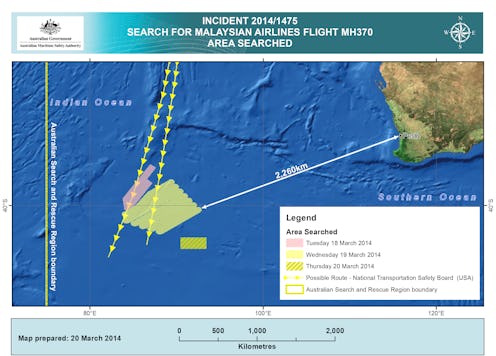News
Debris Sighted In Hunt For Flight 370
It's been called one of the strongest leads to date: Australia said Thursday that two large objects spotted floating in remote seas off the west coast of Australia could be debris from missing Malaysia Airlines Flight 370. The objects were spotted by a satellite four days ago. A Royal Australia Air Force plane has been diverted to scour the area in an attempt to locate the objects, and a Norwegian car carrier has also reached the area.
The effort to locate the two objects — which were spotted about 14 miles from each other in the south Indian Ocean — has been severely hampered by terrible weather in the area. The search plane couldn't spot them through the rain and clouds, and as darkness fell it seemed likely the search would be slowed until Friday morning.
At this point in the search, every moment counts, as authorities race to find the jet's black box that could contain vital information as to the events that occurred on the night the plane went missing. The black box, which periodically emits data pings and contains cockpit voice-recorders, has a battery life of 30 days. In short, time is running out.
The Norwegian car carrier Hoegh St Petersburg was on its way from Madagascar to Melbourne when it received a request from Australian authorities to assist in the investigation of the objects, one of which is around 24 meters long. The smaller object is around 5 meters long, as estimated by the satellite images.
Authorities were quick to caution that there's a good chance these pieces of debris are nothing to do with the missing jet. They could well be something else, like shipping containers that have fallen off a vessel. Some have also expressed concern that a 24-meter hunk is quite a large piece of plane to survive such a crash.
However, many believe that Australia wouldn't have announced that they'd found the objects if they didn't have good reason to believe that there was a decent chance this a part of the missing aircraft.
The search for the objects and verification of whether they are related to the missing jet is expected to be a long and arduous task. Even if the pieces of debris do turn out to be from Flight 370, we still won't be any closer to finding out what actually happened during the flight.
Investigators are hoping that locating the jet's black box could help to provide some clues. Forensic investigators are still attempting to recover the deleted files from the pilot's flight simulator to see whether he was practicing any particular maneuvers such as landing on small islands.
Of course, for the family and friends of the 239 missing passengers, Australia's discovery could mean that their nightmare of uncertainty could soon be over. If the debris is part of the plane, though, it would put an end to the slim possibility that the passengers could have survived.

In the meantime, the search continues along the two vast arcs that Malaysian authorities have designated: One curving north toward Kazakhstan, and the other stretching into the south Indian Ocean. The search is intensifying in the southern corridor close to the Australian satellite spotting. China has said it is redirecting some of its ships toward the area, and the Malaysian navy has dispatched six ships with three helicopters to the area.
Images: Australian Defence/Australian Maritime Safety Authority Via EPA
